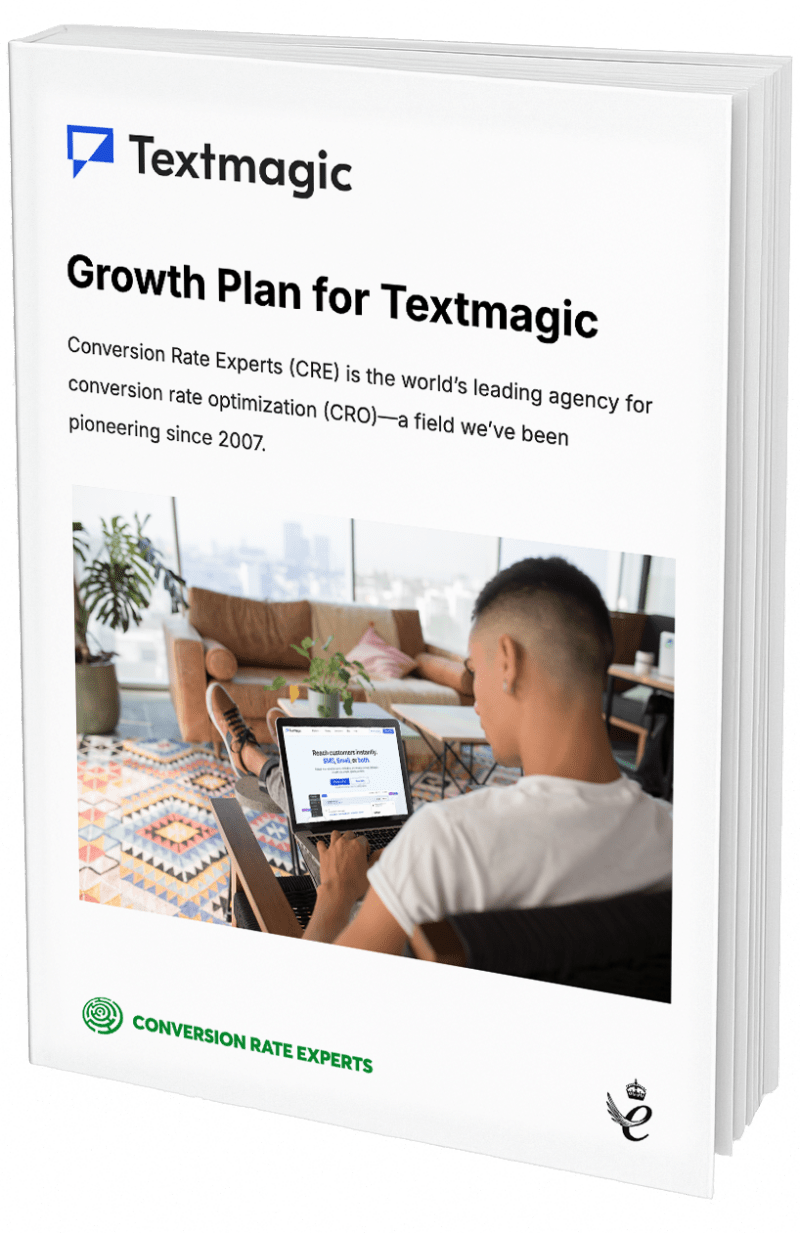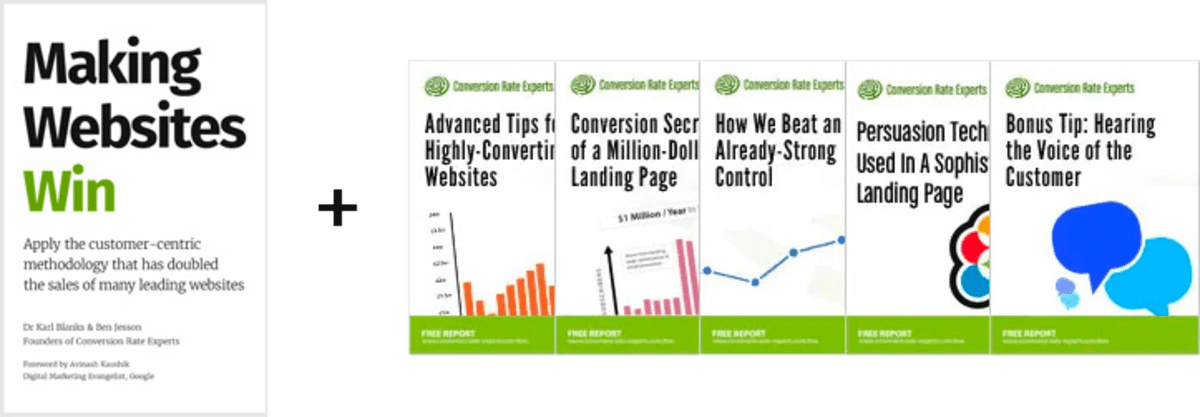The Private Equity Strategy for growing profits without increasing budgets
(By the way, to get articles like this free in your inbox, subscribe to our newsletter.)
We often work with private equity firms because they recognize Conversion Rate Optimization (CRO) as a fast, effective lever for growing portfolio companies—maximizing value and driving highly profitable exits.
And one thing that strikes us every time is their wildly different approach to engineering growth. In this article, we’ll share the private equity mindset and show how you can use it to grow your business without extra investment—solving a challenge many companies face in the current economic climate.
Changing your mindset—think like a private equity firm
Most businesses are hardwired with the mindset that you need to spend more to grow more. More on ads, on your website, on a bigger dev team. The list goes on.
Private equity firms think differently. First, they analyze performance, looking at what’s working and what isn’t. Then, they cut what isn’t working—the waste—and reinvest the savings into scalable, high-leverage growth levers.
In other words, they reallocate underperforming budgets into high-ROI activities. You might argue that most businesses think about efficiency gains, but these initiatives are almost always siloed within individual functions… and it’s tough to achieve breakthrough growth by optimizing in isolation.
While most businesses optimize within silos, private equity firms optimize across them.
A simple way to apply this approach to your business
If you’re already spending money on ads, apply the 80:20 principle to your paid media spend. Identify the least effective ads, pause them, and reinvest the savings into a proven, scalable, high-leverage growth lever.
You could reinvest into your higher-performing ads—but private equity firms tend to aim higher. They look for levers that create lasting value.
That’s why CRO should be the obvious choice. Unlike ads, CRO creates a permanent lift across all your traffic sources—including the ads you chose to keep running.
Here’s the kicker: Because you’re using money that was previously underutilized, this approach allows you to fund CRO without increasing your budget. It’s essentially CRO for free—self-financed by your underperforming spend.
The power of this strategy might not seem groundbreaking (or exciting)… until you see the numbers.
The Private Equity Strategy in action
To see how this works, let’s revisit InflataFish, our favorite fictional online seller of inflatable fishing boats. As it happens, they’ve just been acquired by Rod & Reel Partners, a fictional private equity firm that’s making big waves in the industry.
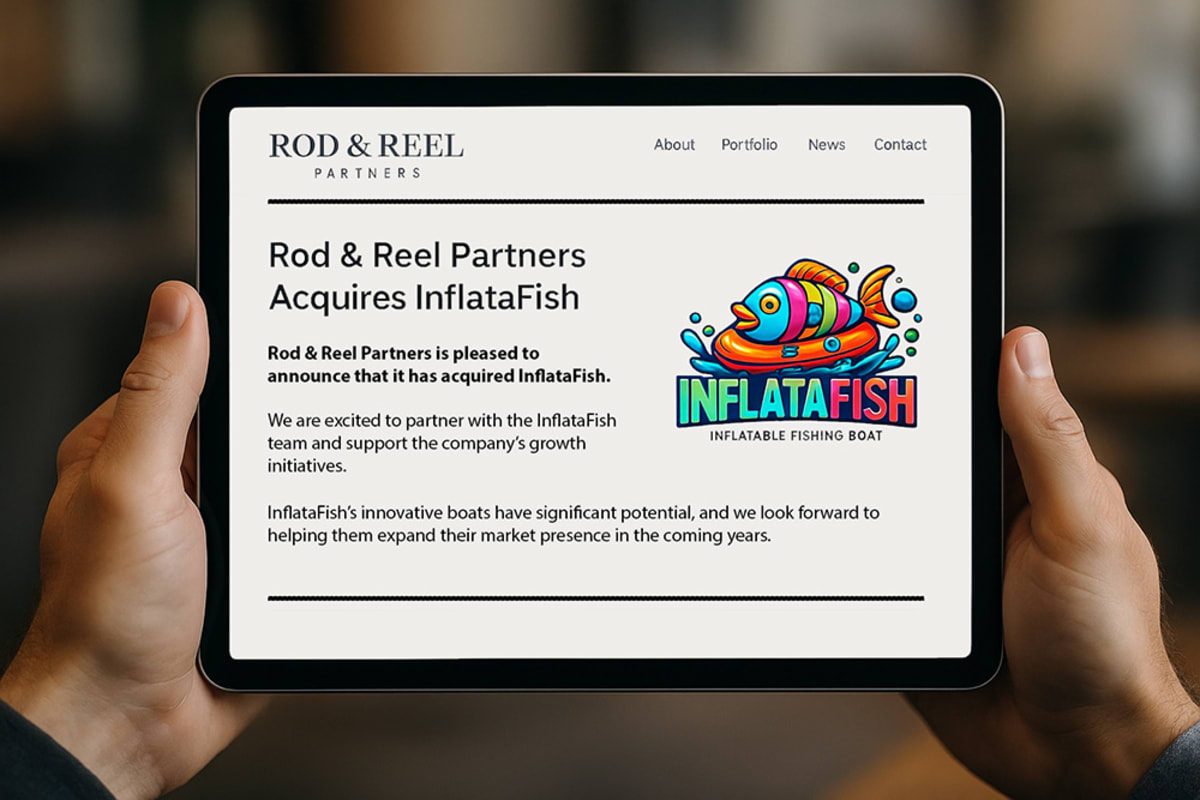
After acquiring InflataFish, the team at Rod & Reel Partners did exactly what any effective private equity firm would do: they opened the books, followed the money, and started asking uncomfortable questions.
Then they applied a classic private equity move: cutting low-performing spend and reallocating it into high-leverage growth levers. In this case, they redirected an under-performing portion of the paid media budget into a Conversion Rate Optimization (CRO) program.
In a previous article, we described how InflataFish spends $195,000 a month on paid advertising, making $328,500 worth of sales—with a 5% net margin that’s $16,425 of profit each month.
InflataFish decided to reallocate 10%—$19,500—of their monthly advertising budget into a 12-month CRO program (by pausing their worst-performing campaigns).
As we can see in this graph, the least effective 10% of the budget (the far-right portion) contributes the fewest sales.
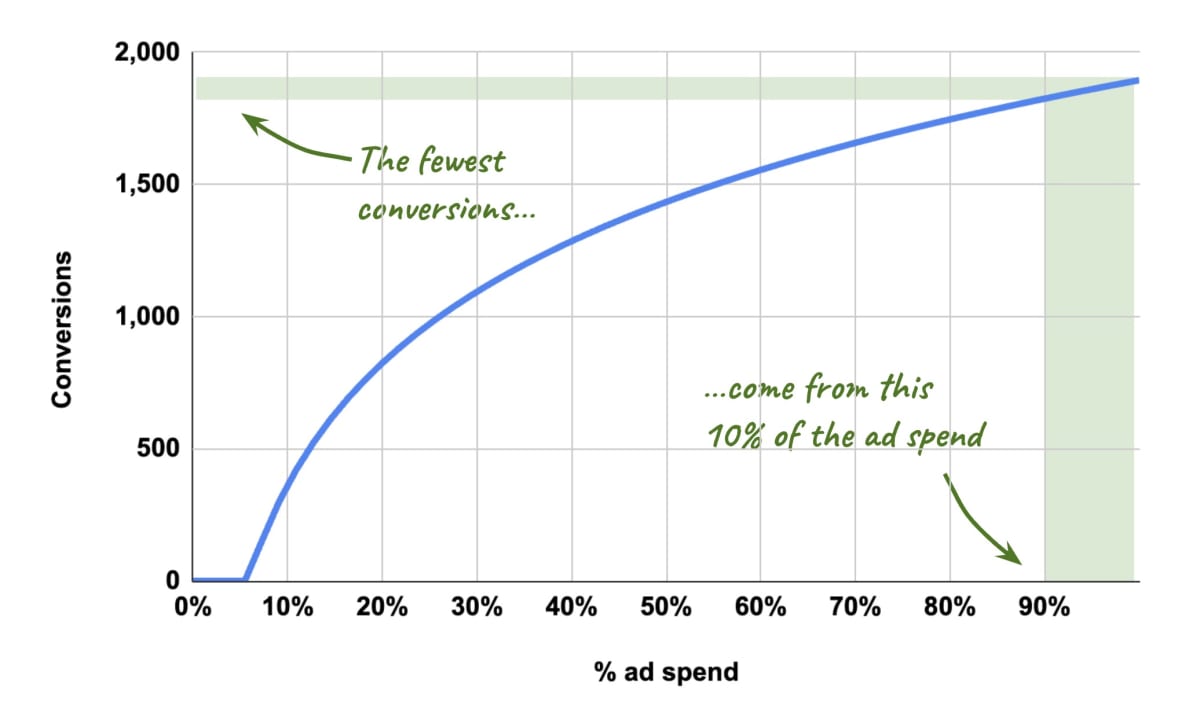
So what happens? Let’s take a look at the results over the next twelve months.
Because InflataFish are reallocating the least effective portion of the budget, sales don’t dip proportionally to ad spend—they decrease by just 3.5%, or $11,500 per month.
Meanwhile, let’s assume that the CRO program achieved an increase in conversion rate of 50% incrementally over the twelve month period, starting in month three.
| Month | Conversion rate |
|---|---|
| 1 | 1.00% |
| 2 | 1.00% |
| 3 | 1.05% |
| 4 | 1.10% |
| 5 | 1.15% |
| 6 | 1.20% |
| 7 | 1.25% |
| 8 | 1.30% |
| 9 | 1.35% |
| 10 | 1.40% |
| 11 | 1.45% |
| 12 | 1.50% |
Let’s take a look at how sales compared over the twelve months, versus the “base case” scenario where InflataFish did nothing.
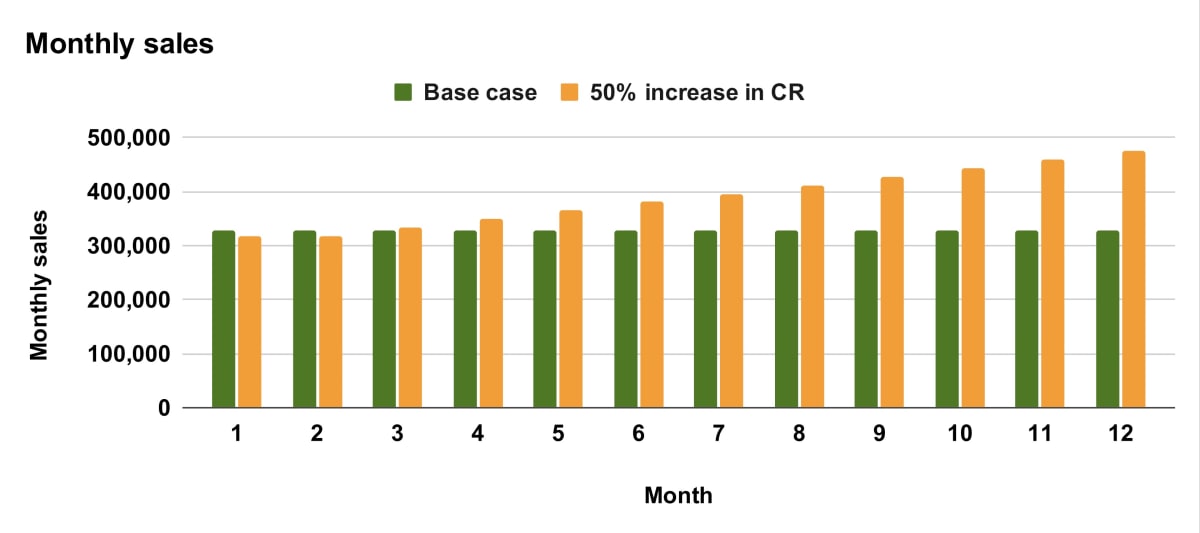
Here’s what happened:
- In month 1, InflataFish spent $19,500 less on paid ads and—because conversion rate is the same—monthly sales dipped by $11,500 (to $317,000).
- In month 2, it was the same story; still no increase in conversion rate and—with the reduced ad spend—monthly sales remained $11,500 down (at $317,000).
- In month 3, the conversion rate increased by 5% to 1.05%, and sales increased by $15,850 to $332,850—already surpassing the monthly sales before starting CRO.
- In month 4, conversion rate increased again to 1.10% and sales accelerated again. They were now $20,200 above the base case and climbing.
…and so on.
Sales increase in direct proportion to conversion rate, surpassing the base case sales in month 3. These show impressive gains, but what do we see when we focus on the monthly profit?
The increase in net profit (including the investment in CRO) is much more dramatic, because the Power Law of CRO is at work. (When your conversion rate increases, your profits grow disproportionately.) For a detailed explanation of this read the Power Law of CRO and our follow-up study, The math behind PPC dominance.
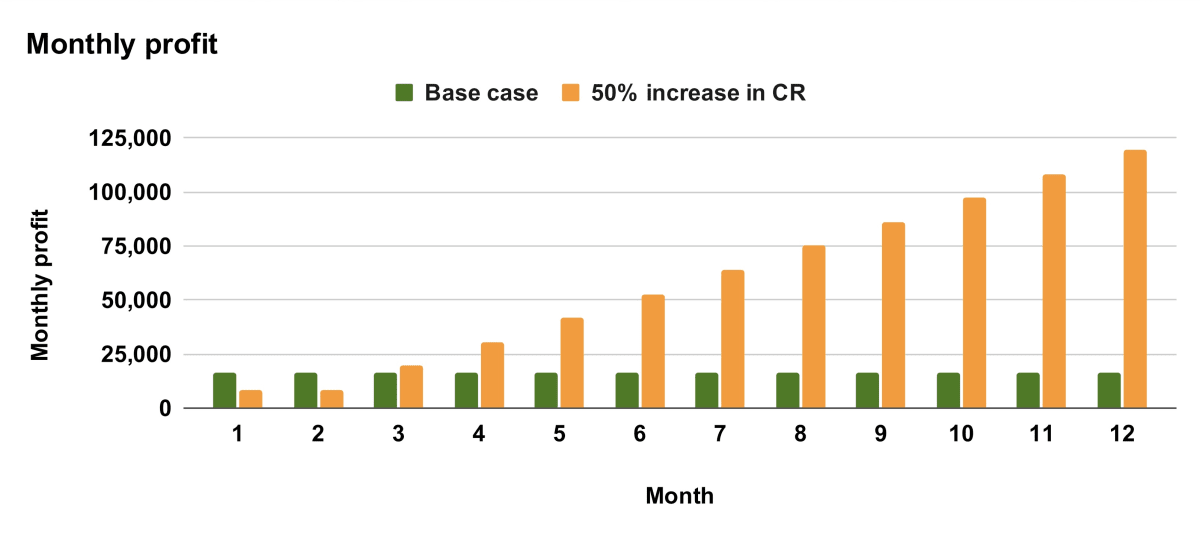
And speaking of dramatic, let’s take a look at the cumulative net profit over the period, versus the base case.
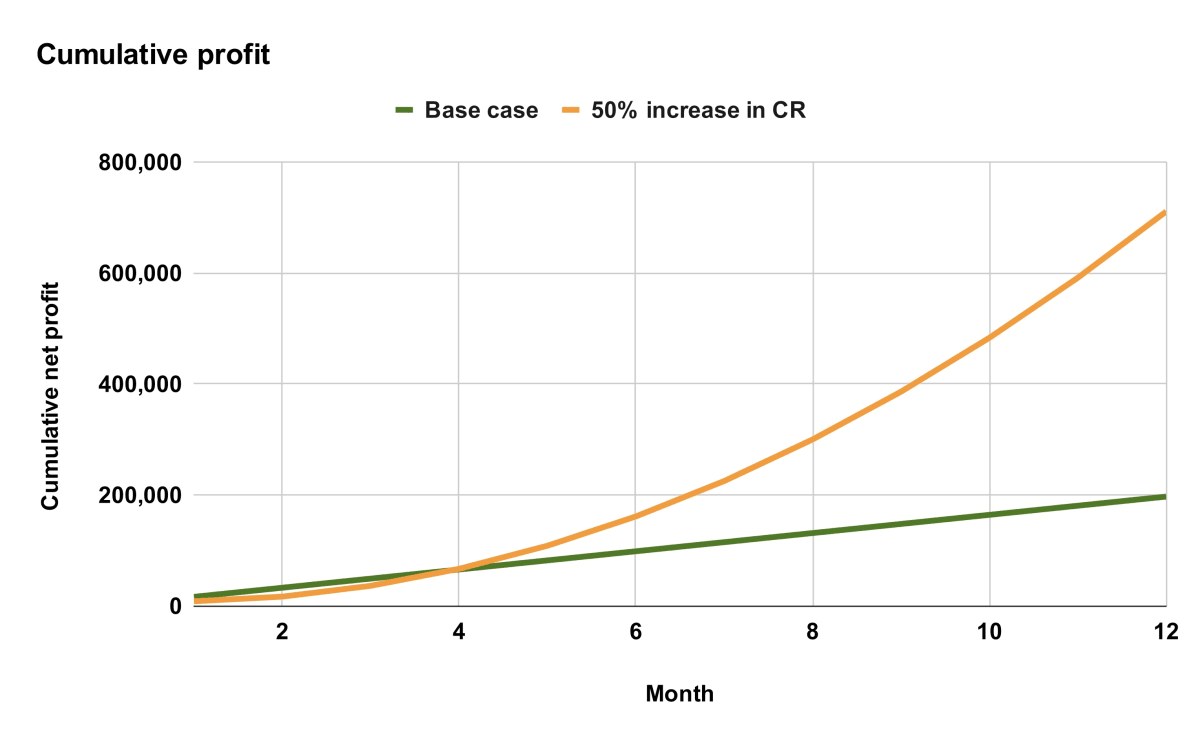
This chart captures the real impact of Rod & Reel Partners’ strategy. At first, profits dip slightly, reflecting reduced sales and the investment in CRO. But by month 4, the breakeven point is reached—the cumulative profit from the reallocation strategy catches up with the “do nothing” scenario. From there, the two paths diverge dramatically. By month 12, the reallocation strategy has outperformed the baseline by 260%, delivering an additional $514,000 in net profit. (Put another way, the cost of not doing CRO would have been over half a million dollars.)
And note the slope of the curve heading into Year 2. Even if you stop working on CRO (and somehow survive your CFO’s wrath), the profit gap continues to widen at the same pace—because CRO creates a permanent lift.
Here’s the same chart taken out to Year 3 (remembering that the investment stopped at the end of Year 1):
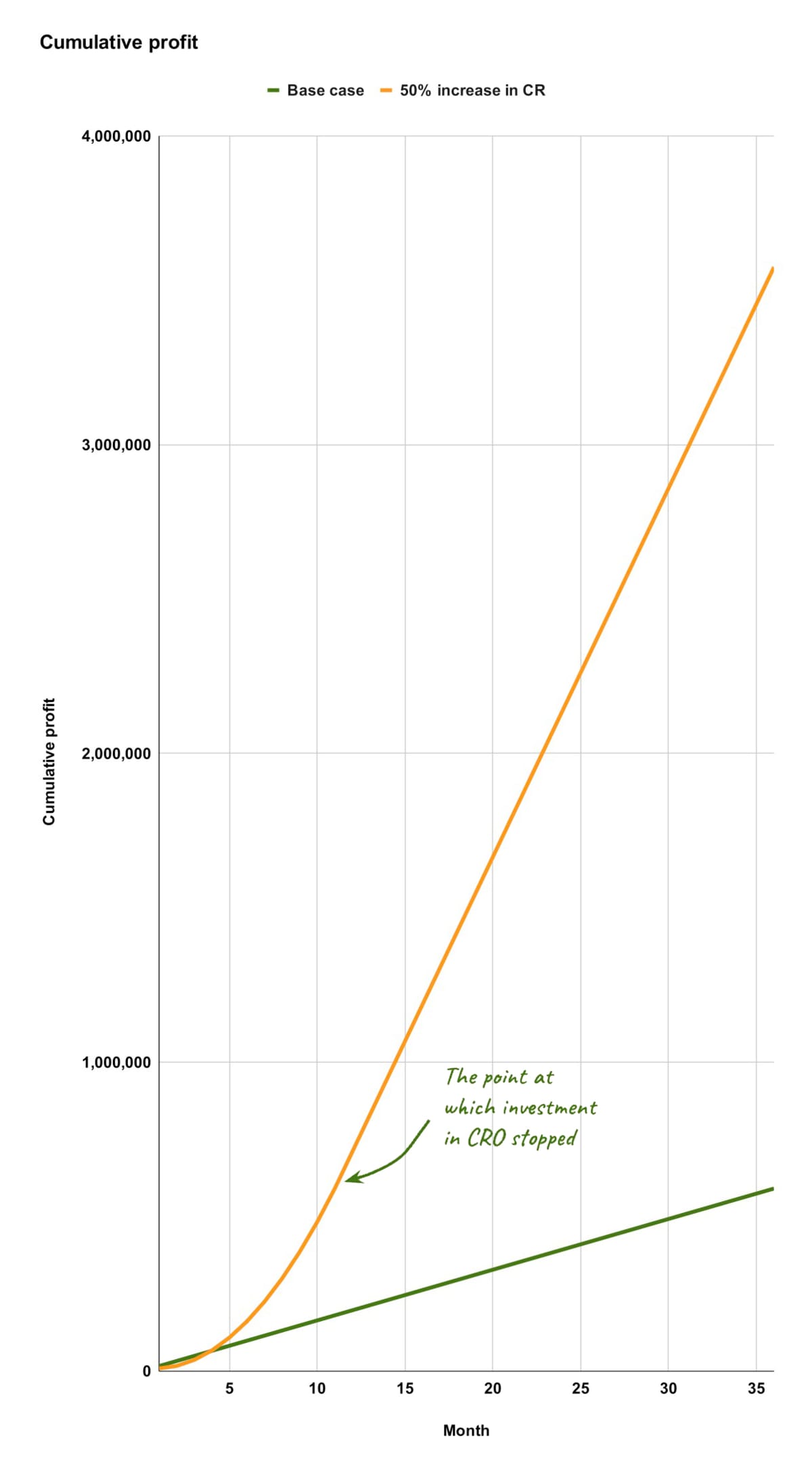
Not all CRO programs are equal
The figures above model the impact of a 50% increase in conversion rate, achieved over a 12-month period, but what if InflataFish beat that goal, or fell short?
To find out, we can use sensitivity analysis, re-running the model with a range of conversion rate improvements—10%, 20%, 50%, and 100%—all achieved incrementally over 12 months. The chart below shows the cumulative net profit for each scenario compared to the baseline of doing nothing.
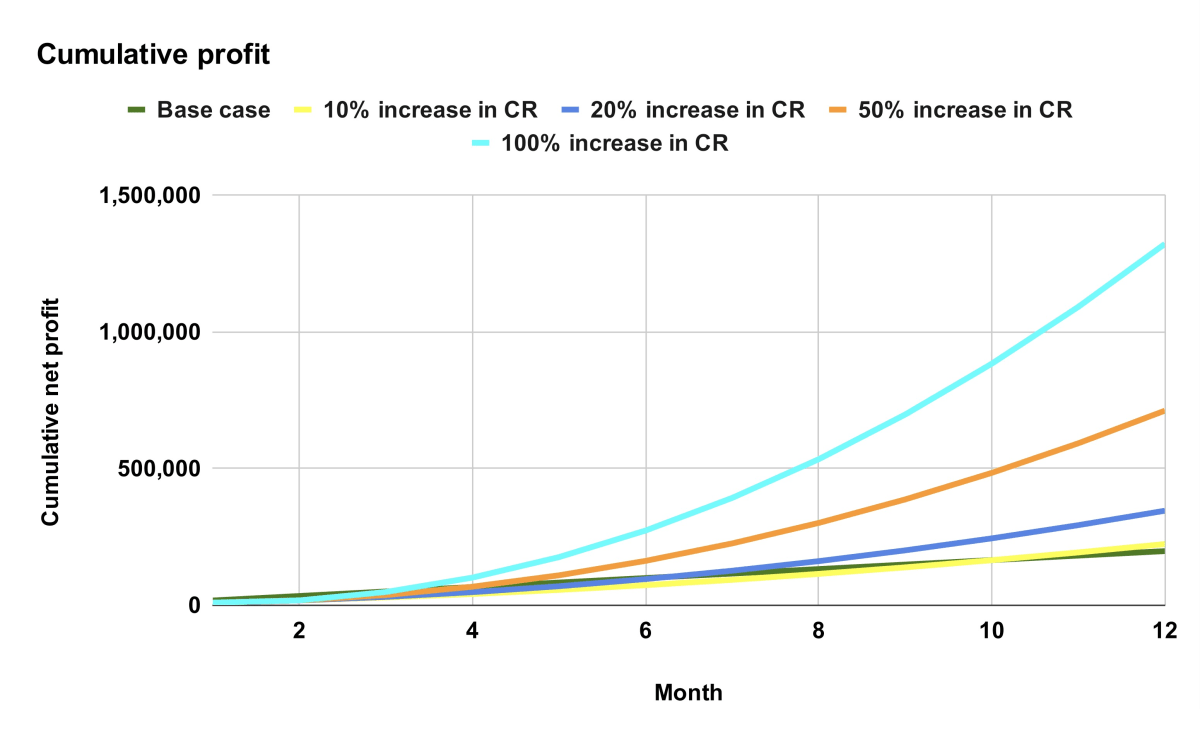
The results are striking.
Even a modest 10% lift in conversion rate (just a 1% gain per month from months 3 to 12) outperforms the base case—and the gap widens over time. The slope of the 10% line heading into Year 2 shows that profits continue to diverge upward—because the gains are permanent.
As the conversion rate increases beyond 10%, the strategy’s ROI becomes increasingly transformational. A 20%, 50%, or 100% lift doesn’t just improve profits—it multiplies them, while building a more resilient, scalable funnel. Unlike ads, which stop working the moment you stop paying, CRO delivers lasting improvements across all traffic sources—paid, organic, referral, and more.
In adopting this approach, InflataFish has moved from chasing growth to driving growth—not with risky bets or budget increases, but with a calculated reallocation of spend into a high-leverage growth lever.
The result? A step-change in performance. And not an extra cent required.
A practical growth strategy for today’s economic climate
The relentless pressure to do more with less often seems like a barrier to growth—but does it have to be? Private equity firms don’t think so because they perfected the art of building value without inflating costs.
When you move investment from poorly performing areas to high-impact growth levers like CRO, you materially improve your business. The Private Equity Strategy is elegantly simple and extraordinarily powerful.
And here’s the best part: You already have everything you need to get started.
Want help modelling this strategy for your business?
Book a free strategy session and one of our consultants will work with you to model the effect of this strategy on your own numbers. No commitment, just clarity.
How much did you like this article?
What’s your goal today?
1. Hire us to grow your company
We’ve generated hundreds of millions for our clients, using our unique CRE Methodology™. To discover how we can help grow your business:
- Read our case studies, client success stories, and video testimonials.
- Learn about us, and our unique values, beliefs and quirks.
- Visit our “Services” page to see the process by which we assess whether we’re a good fit for each other.
- Schedule your FREE website strategy session with one of our renowned experts.
Schedule your FREE strategy session
2. Learn how to do conversion
Download a free copy of our Amazon #1 best-selling book, Making Websites Win, recommended by Google, Facebook, Microsoft, Moz, Econsultancy, and many more industry leaders. You’ll also be subscribed to our email newsletter and notified whenever we publish new articles or have something interesting to share.
Browse hundreds of articles, containing an amazing number of useful tools and techniques. Many readers tell us they have doubled their sales by following the advice in these articles.
Download a free copy of our best-selling book
3. Join our team
If you want to join our team—or discover why our team members love working with us—then see our “Careers” page.
4. Contact us
We help businesses worldwide, so get in touch!
© 2025 Conversion Rate Experts Limited. All rights reserved.

